Genre: Platformer Developer: Data East Publisher: Takara Players: 1-2 Released: 1994
Much like the theoretical asteroid that wiped out the dinosaurs sixty million years ago, video arcades across America were struck by something big in 1991. The arrival of Capcom’s Street Fighter II created an impact only slightly more figurative than its prehistoric counterpart and ignited an explosion of popularity in fighting games with which other genres just couldn’t compete. Deprived of life-giving quarters, it seemed that many of these suddenly obsolete games would follow the mighty dinosaurs towards extinction.
One of the most notable casualties, in my opinion, was the side-scrolling action game (most recognized by the Ghosts ‘N Goblins, Contra, and Metal Slug series). The same year that Capcom sent its meteor into the arcades, the now-defunct Data East quietly released an endearing little game called Joe & Mac: Caveman Ninjas. One of the last of its kind, Joe and Mac was an unsuccessful competitor to the Street Fighter and Mortal Kombat series, but side-scrolling games were still a dominating force in the console market. In 1992 Joe and Mac was ported to all the biggies, including the NES, the SNES, and Sega Genesis (where it lost the Caveman Ninja part of its name).
The premise of the game is simple: when a rival tribe of cavemen abduct the bodacious women from Joe and Mac’s village, the pair must embark on a journey through a number of prehistorically-themed levels to rescue them. Players can go solo with green-toned Joe or team up with a partner (that’s Mac in the blue) for some simultaneous two-player action. At the end of every second level, players can advance to one of two possible stages, ensuring that those wanting to see every level in the game will have to play through at least twice. While ports to the NES and Gameboy removed the two-player functionality and the SNES version added an overworld map (most likely to imply some sort of kinship with the most recent Mario titles), Genesis owners were fortunate enough to receive a straight-forward port of the original arcade game.
Although not quite as lush and vibrant as the original, Joe and Mac still looks fantastic on the Genesis. Levels are diverse and colorful, from grassy plains and raging rivers to craggy mountains and dusty dinosaur graveyards. The large and cartoonishly detailed character sprites exude an amazing amount of personality, particularly the enemy cavemen and the monstrous, screen-filling bosses. The parallax backgrounds look great, especially during the ice cavern stage.
Almost as impressive as the visuals are the impeccable sensibilities retained from its original incarnation. Arcade games are specifically designed to strike a calculated balance between challenge and fun, making sure that you not only have to spend a lot of quarters to see the game through, but you want to as well. In this regard, Joe and Mac is a success. With its simple gameplay, short-and-sweet levels (seriously – not a single stage in this game is over five screens long), and fantastic bosses, the game remains fun and enjoyable even as the relentless difficulty pounds you into the ground.
In the game’s option menu, you can adjust the difficulty level and tweak the number of lives and continues. Even with the game set to “easy” and the number of lives and continues maxed-out, don’t expect to make it too far during the first few tries. The game throws many enemies at you at once, so taking damage is nigh unavoidable past the second area. An eighteen-unit life bar looks encouraging until you realize that you can still only survive two to four hits. Also adding to the difficulty is how slowly your character moves. Obviously to counter the diminutive levels, Joe and Mac don’t cover a lot of ground despite how fast their feet move. Even the high jump (which rockets them to the top of the screen) doesn’t carry you especially far, making the few critical jumps in the game a bit too tricky to pull off. These minor quibbles (in addition to several rather cheap, unavoidable hits in later levels) serve only as reminders of the game’s arcade ancestry and don’t really detract from its overall enjoyment (or add much to it, for that matter).
Joe and Mac can scrape together an arsenal of primitive weapons like spear heads, fireballs, a boomerang and a great stone wheel (you know… your basic ninja stuff). By holding down the fire button, your caveman will pinwheel his arm, powering up the weapon for a larger, stronger attack. Charging for too long, however, will exhaust and effectively stun him, rendering him immobile for a second or two and costing you a few bars of health (sigh… add that to the vast number of ways the game sucks away hit points). Most enemies you defeat, however, will drop health in the form of… sushi? (Hey, I can’t dispute the historical accuracy of cavemen ninjas eating sushi. I wasn’t there).
It’s a shame that the level of quality applied to the graphics and character design wasn’t applied to the sound. The funky, chipper music fits the tone of the game perfectly yet manages to be completely forgettable. Sound effects aren’t so hot either, but I do get a kick out of the fact that the two cavemen sound just like Donald Duck when they’ve been hit. Had the game included a few catchy musical tracks, however, Data East might have had a perfect arcade experience on their hands.
Joe and Mac does so many things right, it’s easy to overlook its few missteps. Although not especially deep by any means, the appeal of its humor and stylized art direction is undeniable, and the difficulty level is considerable without being as oppressive as the Ghouls ‘N Ghost series. The short levels and memorable bosses offer immediate gratification, and the branching paths extend the life of the game beyond its initial playthrough. Joe and Mac may not have the notoriety or wealth of sequels and remixes of the Street Fighter series, but this is an underrated relic that arcade fans would do well to unearth.
SCORE: 8 out of 10

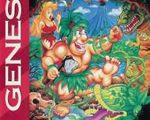
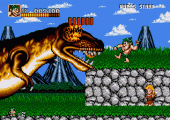
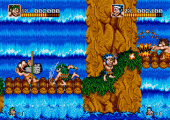
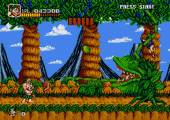
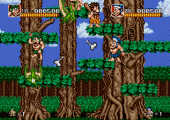
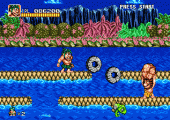
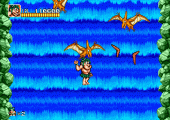
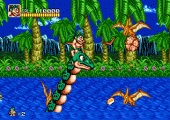
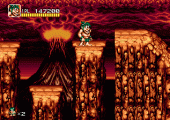
Recent Comments